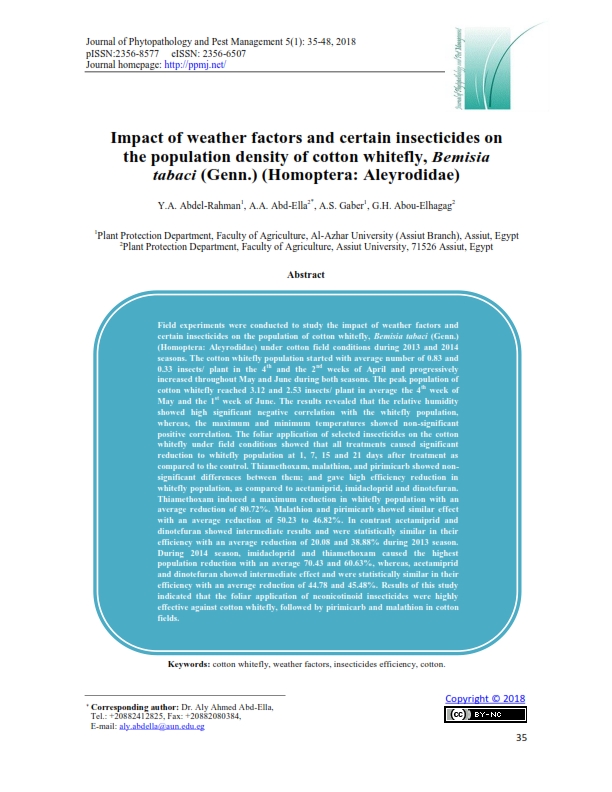Impact of weather factors and certain insecticides on the population density of cotton whitefly, Bemisia tabaci (Genn.) (Homoptera: Aleyrodidae)
Keywords:
cotton whitefly, weather factors, insecticides efficiency, cottonAbstract
Field experiments were conducted to study the impact of weather factors and certain insecticides on the population of cotton whitefly, Bemisia tabaci (Genn.) (Homoptera: Aleyrodidae) under cotton field conditions during 2013 and 2014 seasons. The cotton whitefly population started with average number of 0.83 and 0.33 insects/ plant in the 4th and the 2nd weeks of April and progressively increased throughout May and June during both seasons. The peak population of cotton whitefly reached 3.12 and 2.53 insects/ plant in average the 4th week of May and the 1st week of June. The results revealed that the relative humidity showed high significant negative correlation with the whitefly population, whereas, the maximum and minimum temperatures showed non-significant positive correlation. The foliar application of selected insecticides on the cotton whitefly under field conditions showed that all treatments caused significant reduction to whitefly population at 1, 7, 15 and 21 days after treatment as compared to the control. Thiamethoxam, malathion, and pirimicarb showed non- significant differences between them; and gave high efficiency reduction in whitefly population, as compared to acetamiprid, imidacloprid and dinotefuran. Thiamethoxam induced a maximum reduction in whitefly population with an average reduction of 80.72%. Malathion and pirimicarb showed similar effect with an average reduction of 50.23 to 46.82%. In contrast acetamiprid and dinotefuran showed intermediate results and were statistically similar in their efficiency with an average reduction of 20.08 and 38.88% during 2013 season. During 2014 season, imidacloprid and thiamethoxam caused the highest population reduction with an average 70.43 and 60.63%, whereas, acetamiprid and dinotefuran showed intermediate effect and were statistically similar in their efficiency with an average reduction of 44.78 and 45.48%. Results of this study indicated that the foliar application of neonicotinoid insecticides were highly effective against cotton whitefly, followed by pirimicarb and malathion in cotton fields.
Metrics

Published
How to Cite
Issue
Section
License
Authors who publish with Journal of Phytopathology and Disease Management agree to the following terms:
- Authors retain copyright and grant the journal right of first publication with the work simultaneously licensed under a Creative Commons Attribution License that allows others to share the work with an acknowledgement of the work's authorship and initial publication in this journal.
- Authors retain copyright and grant the journal right of first publication with the work simultaneously licensed under the Creative Commons Attribution-Non Commercial License (CC BY-NC). This allows others to share the work with an acknowledgement of the work's authorship and initial publication in this journal.
- Archives of Agricultural Sciences Journal is an Open Access Journal, and articles published are distributed under the terms of the Creative Commons Attribution-Non Commercial License (CC BY-NC). Readers may copy, distribute, and display the work for non commercial purposes with the proper citation of the original work. However, the journal retains the right to exploit subsidiary rights on behalf of the authors.
- Authors are able to enter into separate, additional contractural arrangements for the non-exclusive distribution of the journal's published version of the work (e.g. post it to an institutional repository or publish it in a book), with an acknowledgement of its initial publication in this journal.
- Authors are permitted and encouraged to post their work online (e.g., in institutional repositories or on their website) prior to and during the submission process with full disclosure to the journal, as it can lead to productive exchanges, as well as earlier and greater citation of published work. Following publication in Archives of Agricultural Sciences Journal, the author should update the repository, and include a citation and link to the published work.
Click here for more information on Licensing policy
.png)




